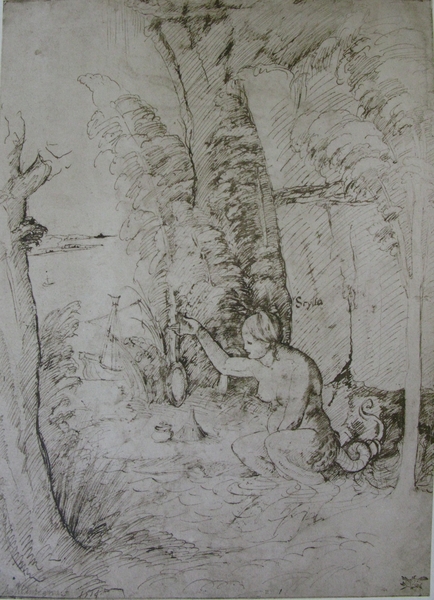Scylla: An illustration to Vergil, Aen. iv, 420-428
Summary
A reproduction produced by the Vasari Society of a drawing from the Northern School. The drawing shows a mythical creature sitting in a stream in a forest. The creature has the head and torso of a woman, the hind of a beast, webbed feet and a snake's tail. An inscription beside this creature identifies her as the character 'Scylla'.She is sitting with her feet in the stream, facing towards the left and holding up a mirror in her right hand, which she is looking into. On the back behind her are two objects which could be used for cooking. There is a large tree in the foreground against the left edge and a group of other trees on the bank behind Scylla. Through an opening in the trees in the left middleground there can be seen an expanse of water with two ships sailing on it. Text from the accompanying booklet produced by the Vasari Society: "No. 8 NORTH ITALIAN SCHOOL (1514) (A) SCYLLA: an illustration to Vergil, Aen. iv, vv. 420-428. (B) ORPHEUS IN HADES: an illustration to Vergil, Georg. iv, vv. 457-484. Collection of Captain E. G. Spencer Churchill, Northwick Park. From the Richardson Collection. Pen and ink. 29.8 x 21.5 cm. (11 11/16 x 8 1/2 in.). These two very entertaining mythological drawings are from the back and front of a single sheet. Their style is unique and very puzzling. The genuine date 1514 appears at the foot of (B), and in the left-hand lower corner of (A) a later hand has repeated the same date and added a false attribution to Mantegna. Both drawings are quite certainly by the same hand, though (A) looks at first sight the abler and more vigorous of the two. The general character of the design and workmanship seems clearly North Italian; so does that of the script in which are written the name of the personages, Orpheus, Eurydice, Tisiphone, Megera, Alecto, and the rest, while marks over the u and y in the names of Pluto and 'Tytios' suggest Northern and not Italian usage, and would seem to point to a hand accustomed also to German and Flemish orthography. Can the artist be the Venetian painter and engraver Jacopo de'Barbari, in that late period of his life when he was settled in Flanders in the employ of the Regent Margaret? Certain points of type and handling are much in his manner, notably the head of Scylla, the growth of the high grasses springing at the foot of the tree opposite her, and the way of covering large spaces with long sweeping strokes as in his engravings. Such marks are much less recognizable in the Orpheus drawing, and on the whole it is safer to name him in connexion with this sheet by way of suggestion merely, not of affirmation. Somewhat analogous qualities are to be recognized in extant mythological paintings by the pseudo-Boccaccino (Giovanni Agostino da Lodi). S. C."
Object Name
Scylla: An illustration to Vergil, Aen. iv, 420-428
Creators Name
Date Created
1914-1915
Dimensions
support: 45.6cm x 38.1cm
accession number
1933.430
Collection Group
Place of creation
Europe
Medium

